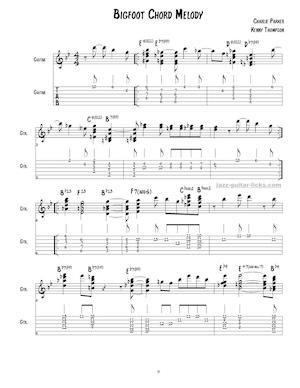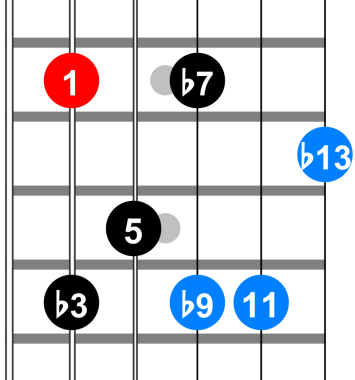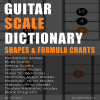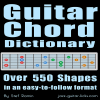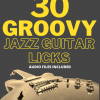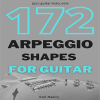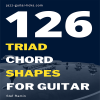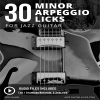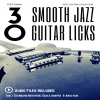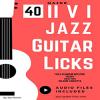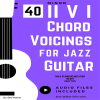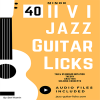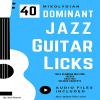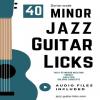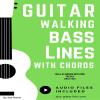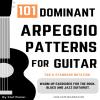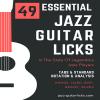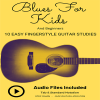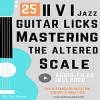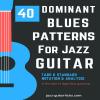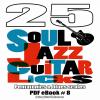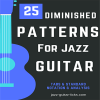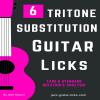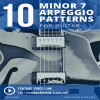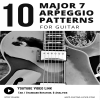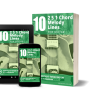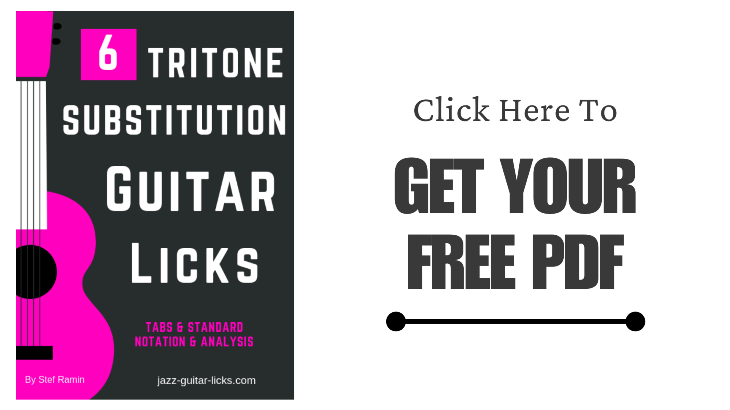Blog - Jazz Guitar Lessons
Welcome,
This blog covers different topics with several useful lessons both for beginners, intermediate and advanced jazz guitar players.
Whether you're looking for tips on playing jazz guitar, this blog surely has the information you crave and will help you expand your music knowledge and technical skills.
Here below many tutorials grouped into several distinct categories:
Jazz Guitar Licks and Transcriptions
Teacher Spotlight - Jazz Guitar Lessons
Cheat Sheets, Methods, Posters, eBooks
The content is regularly updated so don't hesitate to subscribe to the newsletter to receive the latest posts.
-
Diatonic Sixth Chords And 6add9 Arpeggios For Guitar
- By jazz-guitar-licks
- On 2025-07-04
In this lesson, you will learn how to harmonize the major scale in sixth chords and 6add9 arpeggios to add a smooth, jazzy flavor to your playing.
Free PDF available here.
-
Harmonic Minor Scale Arpeggio And Chord Shapes For Guitar
- By jazz-guitar-licks
- On 2025-06-17
- In Scales & Arpeggios
Welcome to this guitar lesson on exploring the arpeggios and chords of the harmonic minor scale—a rich and expressive sound widely used in classical, metal, jazz, and fusion genres
In this lesson, we'll dive into how this scale builds unique chords and arpeggios, including the diminished and augmented types you won’t find in major or natural minor harmony.
You'll learn how to visualize these shapes across the fretboard.
-
Take The A Train - Guitar Chord Melody Arrangement
- By jazz-guitar-licks
- On 2025-06-10
- In Jazz Guitar Lessons
Welcome to this guitar lesson, where we’ll explore a chord melody arrangement of the classic jazz standard Take The "A" Train by Billy Strayhorn.
This tune, famously associated with the Duke Ellington Orchestra, offers a perfect blend of swing rhythm and rich harmony—ideal for showcasing the beauty of chord melody on guitar.
We’ll break down the melody, harmonize it using jazz voicings, and focus on smooth voice leading to bring the tune to life as a solo guitar piece.
-
Bigfoot By Charlie Parker - Guitar Chord Melody Arrangement Lesson
- By jazz-guitar-licks
- On 2025-05-23
- In Teacher Spotlight - Jazz Guitar Lessons
Guest post by Kenny Thompson from the Facebook group The Art of Jazz Guitar.
This guitar lesson is a chord melody arrangement of a Charlie Parker blues head named “Bigfoot”.
-
Diminished Scale Guitar Workout - Chords And Melody - Free PDF And YouTube Short
- By jazz-guitar-licks
- On 2025-04-24
- In Scales & Arpeggios
Welcome to this short lesson where we dive into one of the most mysterious and powerful tools in a guitarist’s arsenal — the diminished scale.
We’ll break down the two main forms of the diminished scale (half-whole and whole-half), explore how they relate to dominant 7♭9, 7#9 and diminished 7th chords.
-
Harmonic Major Scale Chords For Guitar
- By jazz-guitar-licks
- On 2025-04-15
- In Scales & Arpeggios
The Harmonic Major Scale is a unique variation of the major scale, created by lowering the 6th degree.
This small change introduces a mix of major and minor qualities, making it useful in jazz, fusion, classical, and film music.
In this lesson, we’ll explore how to harmonize the scale into triads and 7th chords, uncovering its distinct harmonic colors.
-
What Are Shell Guitar Chords?
- By jazz-guitar-licks
- On 2025-04-13
- In Chords / Voicings
If you’re looking to clean up your chord work, boost your rhythm chops, and sound more intentional on guitar, shell voicings are a must-have tool in your arsenal.
These chord shapes focus on just the essentials—root, 3rd, and 7th—leaving out the extra notes that can muddy your sound.
Whether you play jazz, blues, funk, or even rock, learning shell voicings will transform the way you approach rhythm guitar.
-
Diatonic Chord Progression And Diminished Passing Chords
- By jazz-guitar-licks
- On 2025-03-09
- In Chords / Voicings
In this lesson, we’ll explore how diminished 7 chords can be used to create smooth, voice-led connections between diatonic chords, adding tension, movement, and harmonic richness to your playing.
-
Guitar Pro Giveaway 2025
- By jazz-guitar-licks
- On 2025-02-26
Don't miss out on your chance to win a Guitar pro license.
How To Enter:
- Like & share this post on Facebook
- Follow Jazz Guitar Licks & Guitar Pro
- Tag 2 friends
The 10 winners will be randomly drawn and will receive a private message on Facebook from the official page (Jazz Guitar Licks).
We will send the prizes to the addresses that the winners will indicate.
Giveaway ends March 5, 2025
-
Diatonic Major Scale Triads For Guitar - Four Exercises With Tab & Youtube Short
- By jazz-guitar-licks
- On 2025-02-19
- In Chords / Voicings
Triads are the building blocks of chords and an essential part of understanding harmony on the guitar.
By learning major scale triads, you'll improve your fretboard knowledge, enhance your improvisation skills, and develop a deeper understanding of chord construction.
In this lesson, we’ll break down:
What are the three types of triads found in the major scale.
How to play them across the fretboard on four string sets.
-
The Chicken (Jaco Pastorius) - Biréli Lagrène Guitar Transcription
- By jazz-guitar-licks
- On 2025-01-28
This lesson provides a transcription of The Chicken theme, a clever mix of funky chords and licks by Biréli Lagrène in the album Broadway Blues.
-
Relative Major And Minor Pentatonic Scales For Guitar - 4 Exercises - Lesson For Beginners
- By jazz-guitar-licks
- On 2024-12-19
- In Jazz Guitar Lessons
When exploring improvisation over a major 7 chord on guitar, pentatonic scales offer versatile and melodic options.
This approach allows you to expand your phrasing and musical expression over a single chord using the relative major and minor pentatonic scales.
-
Diatonic Seventh Arpeggios And Extensions For Guitar - PDF & Short Video
- By jazz-guitar-licks
- On 2024-12-13
In this guitar lesson with PDF and Youtube Short, you'll learn how to extend diatonic seventh arpeggios with the 9th, 11th and 13th.
Check this link to get the PDF transcription.
-
Essential Dominant Scales For Guitar - Shapes And Short Video
- By jazz-guitar-licks
- On 2024-12-09
- In Scales & Arpeggios
In this session, we'll cover 6 essential dominant scales that every guitarist should know.
These scales are the foundation for creating solos in blues, jazz, and rock styles
-
Reharmonizing Christmas Carols using Giant Steps chord changes
- By jazz-guitar-licks
- On 2024-12-06
Guest Post By Dennis Winge
Coltrane changes are fun to play on.
If you're intimidated by Giant Steps, it could simply be the tempo of the tune.
Just because Trane's version is fast doesn't mean you can't enjoy using the changes at slower tempos, in smaller increments, and on generally easier tunes.
-
Difference Between Dominant 7 Chord And Diminished 7 Chord - Free PDF and YouTube Short
- By jazz-guitar-licks
- On 2024-11-25
- In Chords / Voicings
-
Guitar Scale Dictionary
This E-book is a printable PDF method including over 700 scale diagrams and formula charts for guitarists. -
Guitar Chord Dictionary
This PDF eBook provides over 550 guitar chord shapes. This is the perfect reference guide to understand how chords are built and how to play them on the guitar neck. -
30 Groovy Jazz Guitar Licks
This downloadable package contains a PDF WITH audio files giving access to 30 groovy guitar phrases mixing jazz, blues and funky licks for beginners. -
172 Arpeggio Shapes For Guitar
This printable PDF is a method dedicated to guitarists of all styles who want to learn build and play the most important types of arpeggios. -
126 Triad Chord Shapes
This handbook for guitar players is intended both for teachers and students. It includes 126 guitar shapes for mastering triads. -
Harmonic Major Scale Chords
this PDF offers diagrams and tabs for guitar to learn the chords of the harmonic major scale. -
Major Scale Harmonization
This package provides a printable PDF with exercises and audio files to learn how to harmonize the major scale with 3 note chords and their extensions. -
30 Minor Arpeggio Licks
This package includes a printable PDF method containing 30 exercises with tabs, staves and audio files for practicing minor arpeggios on guitar. -
II V I Bundle - 170 Exercises
This bundle contains 4 PDF methods for a total of 170 exercises with tabs, staves, analysis & audio files for practicing scales, arpeggios licks & chords over the 2-5-1 progression. -
Diatonic Licks Bundle
This package contains 120 jazz guitar lines based on diatonic modes as Mixolydian, Dorian and Ionian. PDF format with tabs, audio files and analysis. -
30 Smooth Jazz Guitar Licks
In this package you'll get a printable PDF Method with tabs, notation, analysis, scale shapes and audio files for practicing 30 smooth jazz guitar licks. -
40 II V I Jazz Guitar Licks
This pdf method for guitar contains fourteen 2 5 1 jazz guitar lines with tab, standard notation, analysis, scale charts and audio files. -
50 II-V-I voicings
This printable PDF guitar method provides 50 exercises with audio files, analysis, tab and staves for learning major 2-5-1 chord voicings. -
40 Minor 2 5 1 Chord Voicings
This PDF method contains 40 exercices with tabs, scores and audio files for practicing jazz guitar chords over the minor 2 5 1 progression. -
40 Minor II V I Licks
This guitar method is a printable PDF with tabs, diagrams, theory and audio files providing 40 minor 2 5 1 jazz patterns. -
40 Mixolydian Jazz Guitar Lick
PDF guitar method with tabs, audio files and theory providing 40 dominant jazz guitar lines for teachers and students. -
40 Minor Jazz Guitar Licks
This printable guitar method in PDF format contains 40 easy minor jazz guitar lines based on the Dorian mode. -
40 Major Jazz Guitar Licks
Printable PDF eBook method containing 40 major jazz guitar licks with tab, standard notation and audio files for beginners and intermediates. -
Guitar Walking Bass Lines
This jazz guitar method about walking bass lines and chords is available as a PDF files containing 35 exercises with tabs, analysis and audio files -
101 Dominant Arpeggio Patterns
This printable PDF method provides 101 dominant arpeggio exercises with tab, theory and standard notation for the jazz, blues and rock guitarist. -
49 Essential Jazz Lines
This printable eBook method in PDF format provides 49 jazz solo transcriptions of the greatest jazz musicians. Tab, standard notation, audio files & analysis. -
11 Jazz Blues Studies
11 jazz blues chord studies with tabs, standard notation, analysis, and audio recordings and PDF. -
10 Easy Fingerstyle Blues
This PDF with Tabs and audio files provides 10 easy acoustic fingerstyle blues guitar studies for kids and beginners. -
25 Altered Jazz Guitar Lines
This PDF eBook method contains 25 altered jazz guitar licks with tabs, patterns, scale charts and audio files to master, apply and develop the altered scale. -
40 Blues Dominant Patterns
This printable method is available as a PDF file containing 40 easy dominant jazz-blues guitar lines with tabs, standard notation, analysis, audio files and scale charts. -
25 Pentatonic Licks
This jazz guitar method is an eBook available as a PDF with standard notation, guitar tabs, diagrams, analysis, audio files and backing tracks. You will find in this booklet 25 easy jazz guitar lines with theory using common and rare pentatonic scales. -
25 Soul Jazz Guitar Licks
You will find here an eBook available in PDF containing 25 soul jazz and hard bop guitar licks in the style of Grant Green, Melvin Sparks, George Benson. -
25 Diminished Patterns
This eBook PDF with audio files contains 25 dominant diminished jazz guitar patterns using the half-whole diminished scale and diminished 7th arpeggios. -
6 Tritone substitution licks
This Printable PDF eBook available for free download contains 6 easy jazz guitar licks with tabs/notation, youtube video link and analysis about the tritone substitution. -
10 Minor 7 Arpeggio Patterns
This printable PDF eBook offers 10 easy minor 7 arpeggio patterns with its related YouTube video for beginner guitarists. -
10 Easy Major 7 Arpeggio Licks
This is a printable PDF for beginner jazz guitar players providing 10 easy licks to practice major 7 arpeggios. -
10 Chord Melody Lines
Within this package, you'll discover a set of ten chord melody exercises for beginners. Printable PDFaudio files, a backing track, and a link to the associated YouTube video. -
10 Minor Blues Scale Licks
You'll find here a PDF with 10 easy jazz guitar licks to practice the minor blues scale on guitar.
